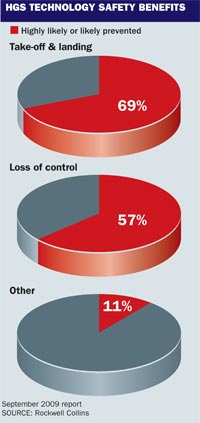THE REMAKE of a 1991 study by the Flight Safety Foundation reveals that head-up guidance systems are even more relevant to safety now than they were almost two decades ago.
Rockwell Collins HGS division, based in Portland, Oregon, tasked the FSF to take another look at its 1991 safety study, which found that an HGS would have prevented or positively influenced the outcome of civil transport accidents looked at between 1959 and 1989.
Prompting the study were questions from Boeing 787 operators who asked: "Why do we have head-up displays on this aircraft?" says John Wilson, director of HGS marketing with Rockwell Collins. "Having an old study didn't help us explain it." The 787 is equipped with dual Rockwell Collins HGS.
 When asking FSF to revisit the study, Rockwell Collins requested that the parameters for accident aircraft be updated to best match the type of aircraft likely to have a HUD. Included were aircraft with a take-off weight of at least 5,670kg (12,500lb) and which entered service no earlier than 1980. The FSF considered the applicable airline, business and general aviation accidents between 1995 and 2007.
When asking FSF to revisit the study, Rockwell Collins requested that the parameters for accident aircraft be updated to best match the type of aircraft likely to have a HUD. Included were aircraft with a take-off weight of at least 5,670kg (12,500lb) and which entered service no earlier than 1980. The FSF considered the applicable airline, business and general aviation accidents between 1995 and 2007.
Rating criteria spanned from "highly likely" that an accident would have been avoided by having HGS to "highly unlikely" or "unknown". Rockwell Collins brought the FSF experts to Portland and demonstrated HGS benefits using a simulator. "We made sure they understood the capabilities and how a pilot uses it."
The FSF determined that the most "influential" safety benefits of an HGS are the flightpath vector (symbology that shows the vector along which the aircraft is moving), the flightpath acceleration indicator (a vertical bar that shows whether an aircraft is accelerating or decelerating) and a speed error tape, an indicator that shows the difference between a pre-set speed "bug" and the actual speed.
Of the 983 accidents reviewed, the FSF determined that an HGS was "likely" or "highly likely" to have prevented 38% of them, up from 31% in the 1991 study. Focusing on the 341 take-off and landing accidents, the FSF determined that 69% could have been avoided with an HGS and 57% of the 123 loss-of-control accidents.
"When something goes wrong - a windshear event or it's turbulent - you're a step ahead," says Wilson. "You already see the state of the aircraft, giving you a safety margin and keeping you engaged."
Source: Flight International




















